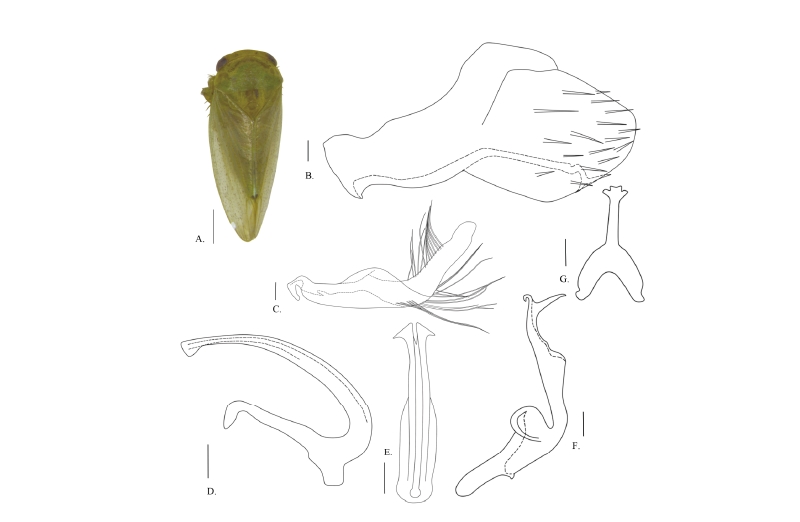Introduction
The subfamily Iassinae belong to the family Cicadellidae (Hemiptera: Auchenorrhyncha). A total of 1,999 species and 124 genera have been recorded in the world (Krishnankutty et al., 2016). This leafhopper subfamily is known as polyphagous pests on oak, elm, grapevine, honeylocust (Lee and Kwon 1977; Gnezdilov, 2008; Nickel et al., 2013). In Korea, two tribes, Batracomorphini Krishnankutty et al. and Iassini Walker, in the subfamily have been recorded (Lee and Kwon, 1979). The genus Batracomorphus is the largest genus consisted of 350 described species in the world (Knight, 1983; Krishnankutty et al., 2016) and can be distinguished from the other genera of subfamily Iassinae by the following characteristics: male pygofer lobe without a pair of appendicular skeleton at base of anal tube; subgenital plate with elongate; style with well-developed and long (Lee and Kwon, 1979; Anufriev and Emeljanov, 1988). In this study, we re-described a newly recorded species of the genus Batracomorphus from Korea. Additionally, we provide a key to the Korean Batracomorphus species.
Materials and methods
The specimens were collected by light trap and sweeping and examined under LEICA M165C and LEICA DMC2900 microscopes (Leica Microsystems, Germany). Morphological terminology follows Dietrich (2005). The abdomen was detached and macerated in 10% KOH for about 20 min. at 70℃ for dissection to examine male genitalia. Specimens examined in this study are deposited at the Laboratory of Systematic Entomology, Chungnam National University (CNU), Daejeon.
Results
Taxonomy
Subfamily Iassinae Walker, 1870
Tribe Batracomorphini Krishnankutty, Dietrich, Dai and Siddappaji, 2016
Genus Batracomorphus Lewis, 1834
Batracomorphus Lewis, 1834: 51. Type species: Batracomorphus irroratus Lewis, 1834.
Acojassus Evans, 1972: 656. Type species: Acojassus montanus Evans, 1972.
Diagnosis. Body length usually shorter than 6 mm or approximately 6 mm. Head with pale green-colored; vertex without distinctly delimited, rounded to face; scutellum with scratched like circumflex. Forewings with pale green, punctate and translucent; clavus with dark spot or not at point of 1/4 from posterior margin. Male’s genital pygofer lobe with process at inner surface in ventral margin; anal tube without appendicular skeleton. Subgenital plate with numerous setae and comparatively long. Style with well developed and elongate; apex of style with bent claw-shaped. Connective with Y-shape, each end of arm more broad than central bone. Aedeagus with single rod; apex of aedeagus with opened and branched or not (for details Anufriev and Emeljanov, 1988; Krishnankutty et al. 2016).
Batracomorphus furcatus Li and Wang, 2003
Batracomorphus furcatus Li and Wang, 2003: 133.
Description. Head pale yellowish green, pronotum yellowish green with variegated dark brown spots. Scutellum with right triangle, scratched like circumflex at middle margin. Forewings translucent and pale yellowish green with punctate; clavus with dark spot at point of one fourth from posterior margin. Legs concolorous with head, without pattern or spot (Fig. 1A).
Genitalia. Pygofer lobe process with branched apex, dorsal branch more longer than ventral one; over reached the posterior end of pygofer lobe (Fig. 1B). Subgenital plate with numerous magrosetae, reachable to process of pygofer lobe (Fig. 1C). Style S-shape with branched apex; dorsal branch with small, recurved (Fig. 1F). Connective Y-shape (Fig. 1G). Aedeagus long and slim (Fig. 1D), with branched apex into two (Fig. 1E). Aedeagus apex ginkgo leaf shape in posterior ventral view (Fig. 1E).
Measurements (mm). Body length males 5.56−5.99, females 8.50−9.19.
Specimens examined. [CNU] 6♂♂1♀, Jichon-ri, Yanggang-myeon, Yeongdong-gun, Chungcheongbuk-do, Korea, light trap, 18.vi.2015, S. Oh leg.; [CNU] 1♀, Jichon-ri, Yanggang-myeon, Yeongdong-gun, Chungcheongbuk-do, Korea, light trap, 24.vi.2014, S. Oh leg.; [CNU] 3♀♀, Jichon-ri, Yanggang-myeon, Yeongdong-gun, Chungcheongbuk-do, Korea, Light trap, 17.vi.2015, S. Kwon leg.; [CNU] 2♀♀, Donam-ri, Geumnam-myeon, Sejong-si, Korea, light trap, 3.vi.2015, S. Kwon leg.; [CNU] 1♀, Chumok-dong, Yuseong-gu, Daejeon, Korea, light trap, 26.iii.2016, T. Lee leg.
Distribution. China, Korea (new record).
Host plants. Unknown.
Key to Korean Batracomorphus species
1. Head green or yellowish green............................................................................................................................2
1'. Head brownish green................................................................................................................... B. punctilliger
2. Vertex without two dark brown spot between compound eyes..........................................................................3
2'. Vertex with two dark brown spot between compound eyes......................................................... B. stigmaticus
3. Forewing with dark brown spots....................................................................................................................... 4
3'. Forewing without dark brown spots................................................................................................ B. viridulus
4. Stylus conspicuously expanded on the middle then branched into two parts at the apex................. B. furcatus
4'. Stylus almost unexpended on the middle then unbranched at the apex ............................................ B. allionii
Conclusion
The members of Batracomorphus have similar body length and general external appearances, so it is very difficult to identify them without examinations of genital structures. For the further studies, it is needs to get genetic information such DNA barcoding for more easy identification as species level.





